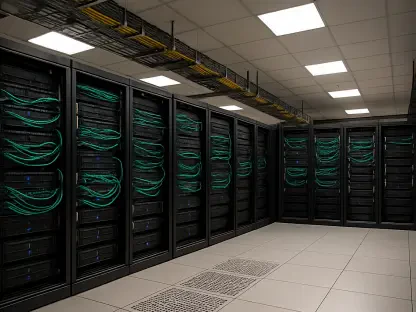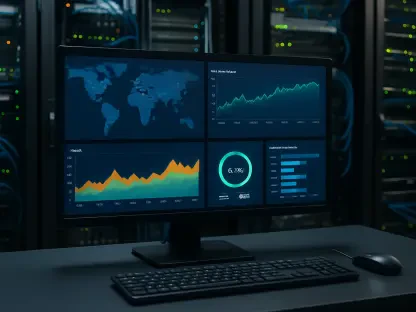What if the blueprint for a massive data center could be tested and perfected without ever breaking ground, saving millions in errors and downtime? In an era where artificial intelligence (AI) and high-performance computing push infrastructure to its limits, Cadence has unveiled a game-changing update to its Reality Digital Twin Platform, integrating Nvidia’s cutting-edge DGX SuperPOD systems. This collaboration is poised to revolutionize how data centers are designed, addressing the skyrocketing demands of power, scale, and efficiency with unprecedented precision.
Why Data Centers Are at a Breaking Point
Modern data centers have evolved far beyond simple server hubs; they are now colossal AI factories grappling with power needs that surge from megawatts to gigawatts. The pressure to support AI workloads, coupled with rising energy costs and sustainability mandates, has exposed the limitations of traditional design methods. Administrators face mounting challenges, from managing dense interconnections to preventing catastrophic downtime, making innovative solutions not just desirable but essential.
The stakes couldn’t be higher. A single design flaw in a gigawatt-scale facility can lead to losses in the tens of millions, while inefficiencies in cooling or power distribution threaten operational stability. Cadence’s latest platform, enhanced by Nvidia’s technology, steps into this critical gap, offering a way to simulate and optimize every detail before physical construction begins, ensuring resilience in an increasingly complex landscape.
Inside the Cadence-Nvidia Powerhouse
The integration of Cadence’s Reality Digital Twin Platform with Nvidia’s DGX SuperPOD, featuring DGX GB200 systems, marks a significant leap in data center design capabilities. This tool allows designers to build virtual replicas using a library of over 14,000 products from 750 vendors, enabling drag-and-drop configurations for compute, networking, storage, power, and cooling systems. Such granularity ensures that every component’s behavior mirrors real-world conditions with striking accuracy.
Beyond basic modeling, this partnership tackles the unique demands of AI factories, where massive processing power and intricate interconnectivity dominate. The platform supports simulations of failure scenarios and capacity upgrades, letting teams test a facility’s response to power surges or cooling breakdowns without risking actual infrastructure. Additionally, physics-based simulations address the shift to liquid cooling—a necessity for managing higher power densities—reducing guesswork in a field where precision is paramount.
A standout example lies in simulating a gigawatt-scale upgrade. Where traditional methods might take months and risk costly oversights, this digital twin approach slashes planning time by allowing iterative testing in a virtual space. The result is a design process that minimizes errors and aligns with exact performance needs, setting a new standard for efficiency.
Voices from the Forefront
Rob Knoth, senior group director at Cadence, emphasizes the transformative potential of this technology. “Retrofitting an existing data center or building from scratch no longer needs to be a gamble—digital twins mitigate risks and enhance efficiency in ways outdated methods can’t,” he explains. His perspective sheds light on the pitfalls of conventional approaches, like constructing oversized facilities without predictive planning, which often lead to wasted resources.
Knoth’s insights resonate with broader industry trends, particularly Nvidia’s dominance in AI hardware and its history of releasing optimized data center blueprints. This strategic alignment between Cadence and Nvidia isn’t just a technical integration; it reflects a shared vision for addressing modern infrastructure challenges. Their collaboration underscores a shift toward simulation-driven design, where foresight replaces trial-and-error tactics that no longer suffice in today’s high-stakes environment.
Real-World Impact for Designers
For data center administrators and architects, the Cadence platform offers practical tools to turn complex challenges into streamlined solutions. Accessing the platform—available now upon request with a wider release planned later in 2025—starts with constructing a virtual model from an extensive vendor library, ensuring every element matches real-world specifications. This initial step lays a foundation for tailored, accurate designs that reflect specific project needs.
From there, scenario testing becomes a powerful asset, allowing teams to simulate conditions like power failures or cooling inefficiencies to pinpoint vulnerabilities before they manifest physically. Designers can also leverage Nvidia’s integrated systems to optimize layouts for AI-driven workloads, ensuring scalability for future demands. This iterative process, where simulations refine plans repeatedly, cuts down on expensive real-world adjustments and accelerates project timelines significantly.
The implications extend across both upgrades and new builds. Whether enhancing an existing facility to handle gigawatt loads or planning a greenfield site for AI applications, this technology empowers stakeholders to make informed decisions. By reducing the likelihood of errors and aligning designs with precise operational goals, the platform redefines what’s possible in infrastructure planning.
A Milestone in Infrastructure Innovation
Looking back, the integration of Cadence’s Reality Digital Twin Platform with Nvidia’s DGX SuperPOD systems stood as a defining moment in data center evolution. It addressed critical pain points—escalating complexity, power demands, and risk mitigation—with a solution that prioritized precision and foresight. The ability to simulate every facet of a facility, from liquid cooling to AI-specific layouts, marked a departure from outdated practices that once hindered progress.
For those navigating this space, the path forward involved embracing such digital tools to stay ahead of industry demands. Exploring platforms like Cadence’s offered a chance to transform design processes, ensuring resilience against future challenges. As data centers continued to underpin global technology, adopting simulation-driven strategies became not just an option, but a cornerstone for sustainable, efficient growth.









